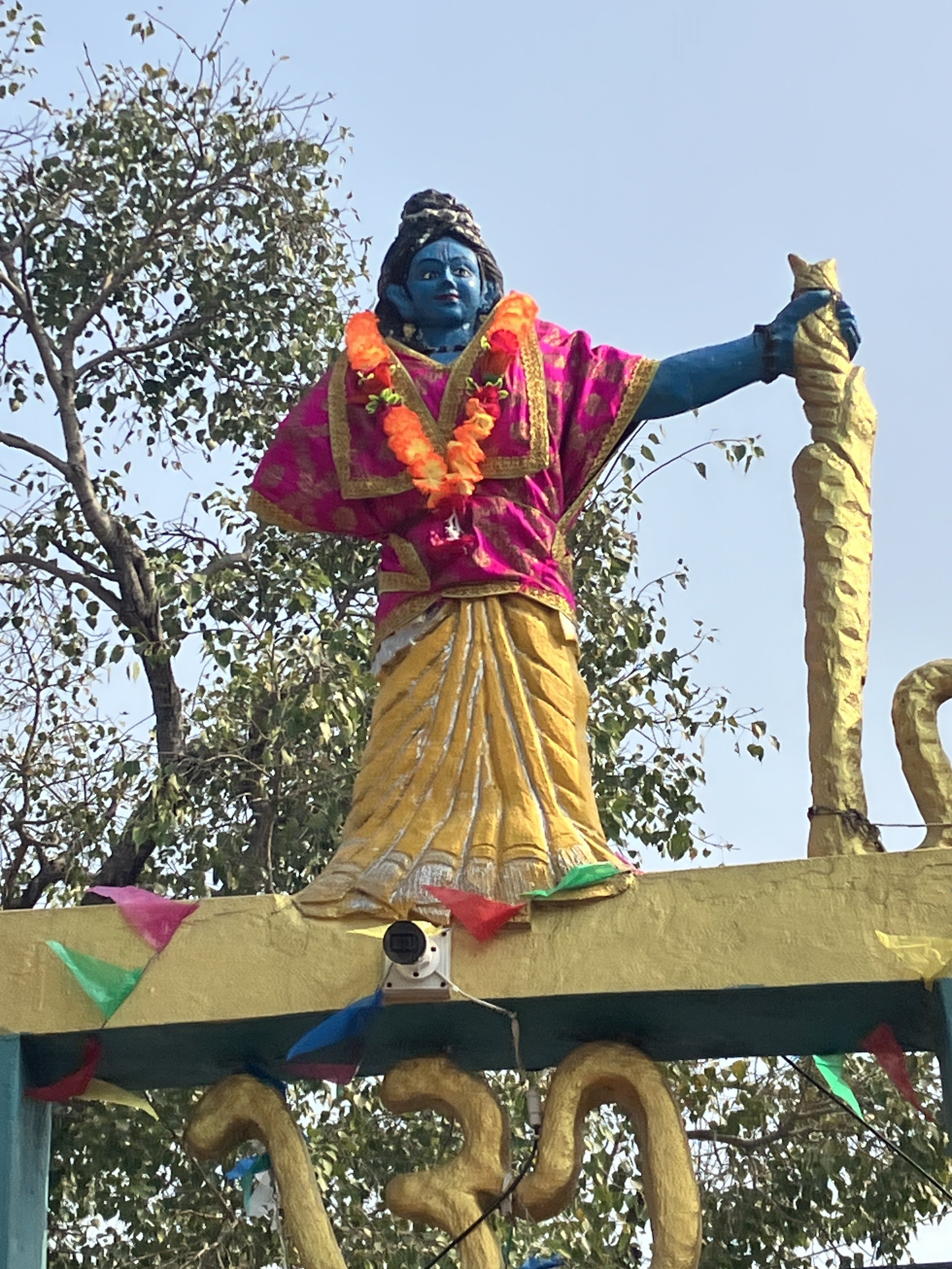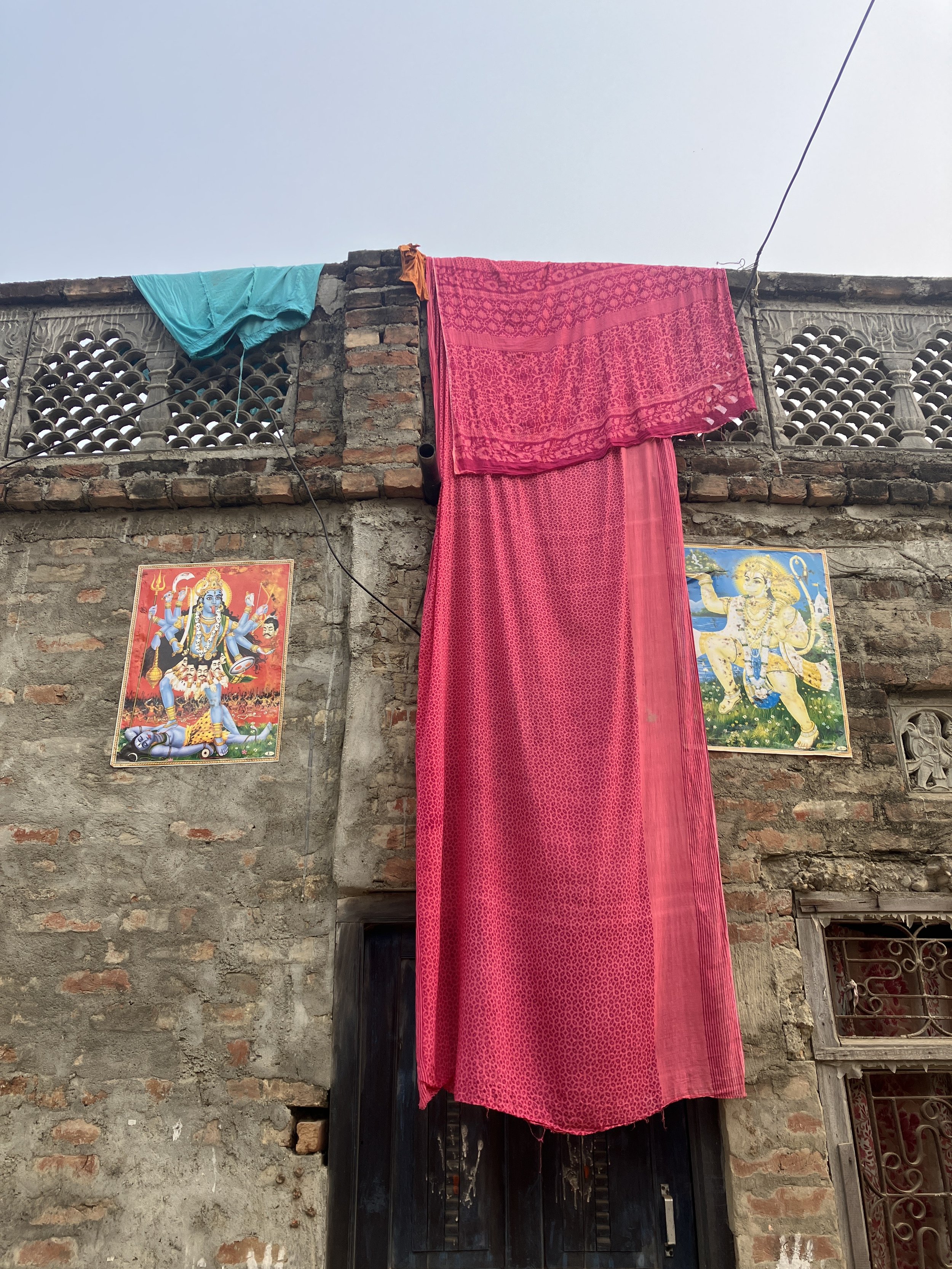Israr Hasan is a Bachelor of Social Science graduate from BRAC University Bangladesh with a degree in Economics and a minor in Anthropology.
When Bangladeshis travel to Nepal, Janakpur rarely features on their itinerary. Far from the luscious mountain ranges of Pokhara and the dizzying roundabouts of hilly terrains in Kathmandu, Janakpur largely remained a city unknown to me. As with any other place, the medium of walking as a method is a deeply imbued mediator of the senses helping to understand the surroundings we live in.
Statue of a Hindu deity. Photo courtesy of the author.
As one engages in aimless wandering around Janakpur—whether on solitary walks or with a group—one encounters a city in mediated transition, reflective of the larger Nepali state. Nepal, once known as the world’s only Hindu kingdom, has transitioned into a multi-party secular democracy, much to the chagrin of its neighbours, whose democratic credentials are increasingly eroded by majoritarian populism, corruption, and foreign interference. Upon leaving the airport premises, visitors are greeted by towering eight-foot statues of Ram and Hanuman dotting the cityscape, figures central to Janakpur’s history. The city itself takes its name from Janaka, the father of Sita, the wife of Ram. To complement these larger-than-life statues, Janakpur asserts its significance through words—most prominently in the form of large posters for Vivah Panchami, the annual commemoration of the union of Ram and Sita. This festival serves as a celebration of love, heritage, rituals, and a collective sense of belonging, transforming the city into a living pilgrimage site. The languages observed on these posters oscillate between Hindi, Maithili, and Nepali.
While navigating Janakpur’s main city, one notices a muscular and proud Hinduism etched onto its buildings. If one squints their eyes harder, they view the internet-famous angry Hanuman flag which traces its origin to Kerala. A local female artist, rooted in Janakpur, contrasted it with the past saying that “growing up, we would see the youthful warm smile of Hanumanji all over Janakpur, and today it is an angry silhouette in any public space”. Embedded in Madhesh, which has been a restive region in the drive for autonomy and greater civil liberties in the not-so-near-past, anger often serves as premium fuel for enacting change. The anger she was speaking here was different. Reeling from the shocks and constant newsheadlines of real and imagined attacks in Bangladesh on “the other”, the difference was that it carried a different colour of imagination. A single colour became a denominator of affinity. Of kinship and loyalty. All too near yet all too distant.
In a sea of small buildings - new and dilapidated - one notices that they are all painted in the colour saffron. Saffron, the colour identified with the Hindu Right in India, is plastered all over the city indicating a strong linkage between faith and identity. In the same vein, one notices a different sort of resilience - rare as it catches the eye yet powerful - of a star and crescent flag fluttering in an ocean of orange coloured buildings and triangular and rectangular flags of orange and saffron. “Everytime someone influential comes from the border, there is a strong impulse to colour the buildings all orange, including ours”, complained Asgar Ali, a Muslim politician who lived in the contours of Rahim Path. On the way to Rahimpath, especially during the time of Vivah Panchami, cries of Jai Shri Ram are heard with horses and bands syncing in mutual awe, confidence, and sheer power. During festivities, such as these, it had been reported that these vehicles come from across the border with Indian title plates. A local interlocutor whispers to me that this is the Vishwa Hindu Parishad, a fiery rightwing party in India which supposedly has branches in Nepal. As a Bangladeshi Muslim with an internationalist and fiercely secular outlook, I found myself navigating the shifting currents of this city—its ripples pulling me into immersion, yet always drawing me back to the surface.
During the night sojourn in Rahimpath, in the midst of green and orange flags identified with the respective communities of the area, I came across a Nepali flag on a mosque standing still while the orange and green flags endlessly fluttered in the background. . In my 8 days in Janakpur, between the battles of colours, the triangular flag was visible only once. Asgar Ali, a man known in the social milieu of Janakpur, lamented that mutual struggle for a separate Madhesi identity as early as 2017 was put behind on the backfoot. Asgar Ali’s house was one of the very few houses that could resist the paint job of Saffronisation that had engulfed the houses of his neighbours and co-religionists. As is common in many parts of South Asia, Urdu is engraved on Muslim owned households and business catering in tailoring, and cobbling - two activities synonymous with contributions of Muslims to the festival of Vivah Panchami. Conversant in fluent Urdu, Asgar dai mentioned the primacy of Urdu to Muslim culture in Janakpur viewing it as integral to an identity bound by link to a past of prestige and power. This showed another cleavage of language reminiscent of the wider struggles over the ownership of Urdu as a Muslim language, strikingly similar to the contexts of greater South Asian Muslims. In nearby Mithileshwar, the landscape was replaced by mosques as one entered the labyrinthe neighbourhood of Hindus and Muslims residing on far flung lanes. The mosques, to my great curiosity, had the name of the mosque engraved in Maithili with the day of its establishment according to the Nepali calndar. In a casual conversation with a group of Muslim elders, they casually remarked to me that “30 generations of us have been Muslim living on this soil, on this land speaking Maithili.”
Doorway decorated with religious images. Photo courtesy of the author.
The doors are marked and segmented by religious symbols. A common marker here is the spectrum of class with doors made of crunched- out wood and dilapidated walls bearing stickers and pictures of gods integral to the story of Ram, including Ram itself, and the 786 number alongside a crescent and star. Hinduness and Muslimness seem to assert themselves with the same gusto. Yet, as one wanders through the city, it is not uncommon to see Hindus and Muslims conversing, rubbing shoulders in the marketplaces, their daily lives intertwined despite the visible markers of difference. As we finished our conversation with the Muslim elders, I bid them farewell with my Salam to which they folded their hands to respond with both Namaste and Walaikum Salam.
Doorway marked with the crescent moon and star. Photo courtesy of the author.
As I travelled to Dhanusagar—first on foot, then by car—I was spellbound by the vibrancy of colours animating the premises: sari-clad women moving gracefully, the heartfelt chatter of children darting through the crowds, the murmured recitations of mantras, and an overarching atmosphere of belonging. Dhanusagar, believed to be the site where Shiva’s bow was found, stands as a pilgrimage point woven with devotion. The scene was a rich tapestry of Hanuman masks, incense curling into the air, and memorabilia of Ram and Sita. Even as an outsider to this faith, I couldn’t help but stand in awe of the deep reverence it inspired in millions. Pilgrims from across Nepal and India—particularly from Bihar—flocked to the site. Not far from here, Janakpur Dham Rail Station, one of Nepal’s only two operational railway lines, further underscored the transnational nature of this pilgrimage. The station’s posters and banners, adorned with images of Ram and Sita, reinforced a growing Hindu brotherhood, transcending borders even amidst the tensions that occasionally mark India-Nepal relations.
Signboard. Photo courtesy of the author.
A kilometre away from the Cultural village, located on the outskirts of the city, where we were staying, there is a large roadside signboard which does not escape the eye on either side of the road. Written in Nepali, the signboard declares boldly that this is “a safe Hindu village”. In consternation, the walker, if he can read, might ask from whom? Located between two orphanages-cum-schools, the sign is adorned with fresh, bright orange flags signalling their recent placement. The message, silent yet resounding, lingers in the mind of any passer-by who cares to read.
Every road carries a story in Janakpur, steeped in historical and mythical significance. As one walks through the city, visiting its numerous temples, including the famous Janaki Mandir, ponds, lakes, and mosques, the intertwined threads of sacral order and harmony gradually reveal a deep uncertainty about the future. The city evokes a sense of awe, as it aspires to something greater, yet remains at a crossroads. For an outsider, it’s often too much to see and too early to make conclusions. Just as walking involves various movements, orientations, and distractions, Janakpur finds itself in diverse trajectories of being steeped in time yet simultaneously searching for its place. The quest for belonging lurks in the background for the city to reveal itself.
The author would like to thank all the organizers, especially Dr. Sabin, Dr. Sasanka, the Cultural Village, the artists, the interlocutors, and the participants of the Winter School for the enriching knowledge-sharing experiences, punctuated by lively discussions and endless cups of tea.












